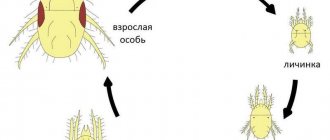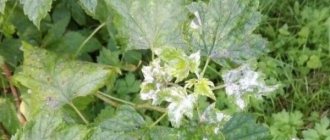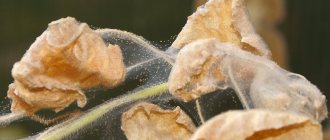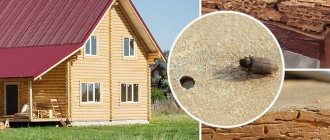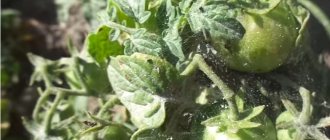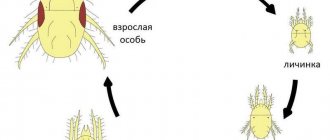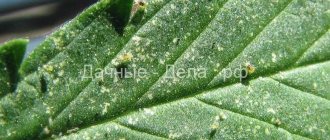The common spider mite or Tetranychus urticae is one of the main pests of nightshade crops. In particular, the arachnid parasite poses a danger to peppers, both seedlings and adult plants. The phytophage gnaws through tissue and draws juice from young leaves and shoots. The plant stops developing, withers and dies. In order not to be left without a harvest, every vegetable grower should know what spider mites look like on peppers and how to deal with them.
Description of the pest
Spider mites belong to the class of arachnids. These insects are distinguished by their tiny size and ellipsoidal shape. Their body length ranges from 0.3 to 0.6 mm. Female ticks are larger than males. As for color, it depends on the stage of development of the pest and the time of year. The most common ticks are yellow, green and brown. At the end of summer, females that are preparing for the winter turn red or orange.
The most favorable conditions for the growth and reproduction of pests are 25-27 degrees Celsius with low air humidity. They are distributed in the following ways:
- females are carried by the wind along with the web;
- insects crawl onto a neighboring plant on the ground;
- pests migrate by clinging to animal fur or human clothing.
Once on a plant leaf, the female begins to feed on its juice and actively produce cobwebs. It serves to protect insects from unfavorable factors such as rain and wind, and with sufficient density it can also withstand chemical treatment.
The web also serves as the boundary of an individual colony and creates a suitable microclimate for the development of larvae.
At one time, the female spider mite lays several hundred eggs. The larvae that hatch from them become adults after 25 days and begin to reproduce themselves. The life cycle of an individual is from 30 to 50 days, so if the pest is not dealt with, in a short period of time they can colonize and destroy many plants.
Females and the eggs they lay are able to overwinter in the foliage layer, crevices of greenhouses or in the bark of trees. With the onset of warm weather, they wake up and continue to harm garden crops. This must be taken into account when fighting ticks.
Secrets of prevention
Preventive measures that will help prevent spider mite infestations are quite simple. They consist of basic plant care. If peppers planted in the ground suffer from drought, it is necessary to maintain high humidity in the beds, water the seedlings, spray them or wash them with a garden hose. Particular attention here should be paid to the underside of the leaves of the seedlings - it is in this place that the parasite most often settles, so such areas need a more thorough “souling”.
Digging the soil in autumn will also help avoid infection, causing the death of spider mite eggs. It is imperative to burn weeds, fallen leaves and other post-harvest residues, which become an ideal place for the reproduction of parasite colonies.
Damage caused
Larvae and adults of spider mites feed on plant sap, sucking it out of the leaves. First, light green spots appear at the site of the lesion, and later, if no action is taken, the leaves gradually dry out and die.
The danger also lies in the fact that these pests are carriers of various diseases. Since the immunity of such plants is weakened, the disease develops and progresses quite quickly. Vegetable crops are especially often affected by gray rot and various types of mosaics. Peppers can suffer from mycoplasmosis, eggplants can suffer from viral necrosis, and tomatoes can suffer from aspermia, streak and spotted wilt.
Why is it dangerous?
First of all, spider mites lead to disturbances in the metabolic processes of the plant.
Pest attacks are accompanied by the following negative consequences:
- weakening of seedlings due to moisture deficiency (the mite sucks out all the beneficial substances from the bush);
- the web interferes with the process of photosynthesis;
- the plant’s immunity weakens, and as a result it is susceptible to various infectious diseases;
- Peppers affected by mites are susceptible to mosaic and mycoplasma.
As a result, the activity of the pest has a detrimental effect on the bush and can destroy the entire crop, so the mite should be dealt with immediately. The sooner the fight begins, the better the prospects.
Signs and causes of damage
If you carefully observe the plants, it will not be difficult to notice the appearance of pests on their leaves. This can be understood by the following signs:
- The appearance of small through punctures on the sheet plate. If you look closely at the back of the leaf, you can see the insects themselves. Since ticks are very small, they will appear as moving dots.
- The appearance of a thin sticky web on the leaves, as well as between them and the stems.
- Change of leaf color from bright green to pale green and later to yellow.
- Slowing growth and development of the crop, falling of buds, flowers and ovaries, drying of fruits. This is typical for the most advanced stage of the lesion if no measures have been taken.
The pest most often affects peppers and eggplants. Tomatoes are more resistant to attack by these insects, but if favorable conditions are created, they may not resist. There are a number of factors that contribute to the growth of the spider mite population on vegetable crops. These include:
- The air temperature is above 25 degrees.
- Humidity 40−50%.
- Lack of moisture in plants. This leads to an increase in the content of soluble carbohydrates in the tissues of vegetables, which helps to increase the fertility of ticks.
- Excessive nitrogen fertilizing. The accumulation of this element in plant leaves favors the development of pests.
In the middle zone, plants are most often affected in greenhouses, and in the southern regions the mite is especially active in open ground.
How do you know if a pepper is affected?
Signs of infection on a pepper can be seen with the naked eye (see photo), unlike the mite itself - it will only be visible under a magnifying glass.
If the parasite settles on seedlings, it will form:
- Small dots of a silvery-yellow color, similar in appearance to pin pricks or small needles.
- With more severe damage, the dots turn into solid transparent spots.
- Light spots and a thin cobweb-like network develop on the back of pepper leaves.
- The last stage of the attack is the entwining of the stems and leaves of the pepper with cobwebs, which causes the seedling to dry out.
The body of a spider mite is small, only 1-2 mm, and depending on the variety, there may be 4 or 8 limbs. Peppers affected by it lose their immunity, become stunted and susceptible to many diseases that the parasite carries in its saliva. If timely treatment measures are not taken, the percentage of plant loss can reach 60% or even exceed this mark.
Three ways to kill ticks
There are various measures to control spider mites on peppers and other crops. Which type to choose depends both on the degree of damage to the crop and on the capabilities and preferences of the gardener. The sooner you start fighting the pest, the faster you can get rid of it.
Chemical methods
They are based on the use of a variety of chemicals, which are produced in abundance by industry. All drugs can be divided into 2 groups:
- Acaricides. They only work on ticks. This group includes Apollo, Neoron, Antiklesch, Floromite.
- Insectoacaricides. Capable of destroying other harmful insects. This group includes such products as Actellik, Oberon, Nissoran.
Chemicals are used for spraying plants, treating soil and fumigating greenhouse structures. These activities can be carried out either selectively or in combination.
When choosing this method, do not forget that drugs can harm human health. Therefore, when using them, you should be careful and try to avoid contact of the products with the skin, as well as protect your eyes and respiratory organs.
Ticks quickly adapt to a specific drug. This means that they need to be constantly changed. If you use the same product for several seasons in a row, it will lose its effectiveness.
Biological methods
They allow you to get rid of pests using products that are completely safe for people, pets and beneficial insects. This is achieved through the use of both special biological products and phytophages. The most common drugs are Fitoverm, Actofit, Akarin, Kleschevit.
Phytophages are special types of predatory mites that feed on pests without causing damage to the plant itself. There are 2 types of phytophages: phytoseiulus and amblyseius. They can be purchased at a specialty store and used in accordance with the instructions.
Agrotechnical control measures
They include a set of measures that are aimed at creating unbearable living conditions for pests. Activities must be carried out regularly and comprehensively. This includes soil cultivation, timely destruction of plant residues, air humidification and planting plants whose aroma the pest cannot tolerate. Among them are mustard, basil, calendula, wormwood.
The advantages of this method include the absence of cash investments. The main thing that is required from the gardener is constant monitoring of the plants, as well as the condition of the air and soil. If you do not forget about this, the ticks will gradually disappear.
Medvedka
The mole cricket is a pest that feeds not only on plant roots, but also on root crops. The insect moves underground, digging tunnels for itself, like a mole. It runs quickly across the surface, so you need to be very vigilant to kill it. Their head is large, the jaw is massive, the body is brown, the legs are small but strong, and they also have wings. The mole cricket flies at night. During the season, one individual can lay 200-300 larvae.
Folk and agrotechnical methods of struggle:
- To protect the greenhouse with seedlings, it is necessary to make small grooves into which sand soaked in kerosene is poured. The smell of fuel will repel the mole cricket;
- When planting pepper seedlings, it is recommended to place needles of coniferous trees (pine, fir) in the holes. It is believed that the mole cricket is repelled by this smell;
- destroy mole cricket nests. You can place pieces of humus in the area where the insect most often lays larvae. Periodically check for nests and, if found, burn them;
- if a mole cricket appears in the garden, then it is impossible to feed the plants with humus from cow manure, since it is a favorable place for their reproduction;
- Fill the pest's holes with soapy water. Some time after treatment with the soap mixture, the insect located underground will come to the surface, all you have to do is kill it.
Chemical methods of control:
- "Medvedox" is an organophosphorus drug for combating mole crickets. Consumption per square meter is 100 grams. It is applied to a depth of 5-10 cm or when planting plants in holes;
- "Phenaxin" is a non-phytotoxic drug with a duration of action of 20 days. Apply to a depth of 5 cm. Consumption per 10 m² is 100 grams. After eating the drug, the death of the mole cricket occurs within three hours;
- "Rofatox" is a chemical preparation based on imidacloprid that works well against mole crickets and wireworms. 30 grams of the drug are needed per 10 m². Place the substance to a depth of 3-5 cm.
Folk recipes
Traditional methods involve treating affected crops with infusions, decoctions and solutions made from improvised means. This method is most effective at the initial stage of damage, as well as as a preventive measure. Here are some recipes for getting rid of ticks:
- Washing leaves with a solution based on laundry soap. To prepare it, a bar of soap is dissolved in 10 liters of water. A sponge is soaked in the solution and the leaves of the plant are wiped with it.
- Spraying with tobacco decoction. Take 400 g of dry tobacco dust, pour it into a 10-liter bucket of water and leave it for a day. After this, the solution should be boiled and filtered. When it cools down, dilute 50 g of laundry soap in the solution and add another 10 liters of water.
- Treatment with onion peel solution. 100 g of husk is poured into 5 liters of warm water and infused for 5 days, then filtered. Spraying is carried out every 5 days.
- Using garlic infusion. 250 g of garlic is thoroughly crushed, filled with 1.5 liters of water and left for 5 days in a dark place. To use, you need to take 30 g of strained infusion and dilute it in 5 liters of water, adding 25 g of laundry soap.
- Using dandelion infusion. 200 g of roots or 250 g of leaves of the plant are first crushed and infused for 3 hours in 5 liters of warm water, and then the solution is filtered.
Any folk remedies must be used every 10-14 days. A one-time treatment will not help here. It is better to grate the soap and add it immediately before using the solution. Processing is carried out in the evening hours. In open ground, spraying is carried out only in dry weather.
Scoops
Inconspicuous gray-brown butterflies become active at night. Fertile females lay colonies of eggs, from which hundreds of greenish ribbed caterpillars emerge in early summer. The larvae devour leaves, shoots, and ovaries of peppers and damage developing fruits.
In favorable conditions, two generations of caterpillars may appear over the summer, causing enormous damage to garden plantings. When the number of insects is small, they are collected manually, and the plants are sprinkled with water. It is recommended to dig up the beds in the fall and install traps with sweet molasses, which attracts caterpillars.
In extreme cases, chemicals are used:
- Volaton;
- Sherpa;
- Arrivo;
- Decis;
- Zolon.
Preventive actions
Prevention is especially important to prevent mites from appearing on vegetable crops next season. In the autumn season, the following actions must be taken:
- after harvesting, burn all infected plants;
- remove the top layer of soil by 3-5 cm;
- treat greenhouses, garden tools and paths with a solution of bleach at the rate of 400 g of the substance per 10 liters of water;
- thoroughly destroy all weeds near greenhouses and beds.
If measures to combat spider mites on tomatoes and other vegetable crops are carried out in a timely manner, the harvest can be saved. Therefore, the main task of the gardener is to regularly inspect the plants and choose the right way to get rid of the pest.
Whitefly
Elderly people and gardeners with poor eyesight may find it difficult to detect whiteflies on their property. Despite the striking appearance of the adults (4 snow-white wings of the insect seem to be sprinkled with flour), the whitefly is a secretive and cautious pest. The length of its body (light yellow color) is only 3-5 mm, and most of the time it hides on the inside of the leaves. Inexperienced gardeners often confuse whiteflies with moths, which for some reason run very quickly if touched, and only then take off. Insect larvae are even smaller and look like transparent blisters or growths.
Peppers are attacked by the greenhouse whitefly. It is discovered by chance - you can, for example, shake a leaf and see a swarm of small midges that take off and begin to circle around the plants. The inside of the leaves becomes sticky and becomes covered with small light spots - these are traces of parasite secretions (honeydew or honeydew). In this nutrient medium, a fungus multiplies, which leads to oppression of the leaves, they become white and yellow (as in chlorosis), and then suddenly turn black and die. Thus, the cause of the death of pepper is not the insect itself, but the fungal and infectious diseases it carries and causes (powdery mildew, mosaic, gray rot).
Measures to combat whitefly:
|
Reviews from gardeners
Maria, Moscow
Chemistry and only chemistry. Go to your local garden store and ask them for something for spider mites. Immediately tune in to 2-3 treatments. During processing, it is better to place the seedlings in plastic bags to increase the humidity level - spider mites cannot tolerate humid air
Source: 7dach.ru
Olga, Tver
Spider mites cannot tolerate ultraviolet rays. It is not for nothing that in nature it hides under the leaves from the daytime sun, so you can irradiate the seedlings with an ultraviolet lamp. A session of 1.5-2 minutes of lighting once a week will reduce the number of mites and increase the plants' resistance to many diseases.
Source: dacha.wcb.ru


